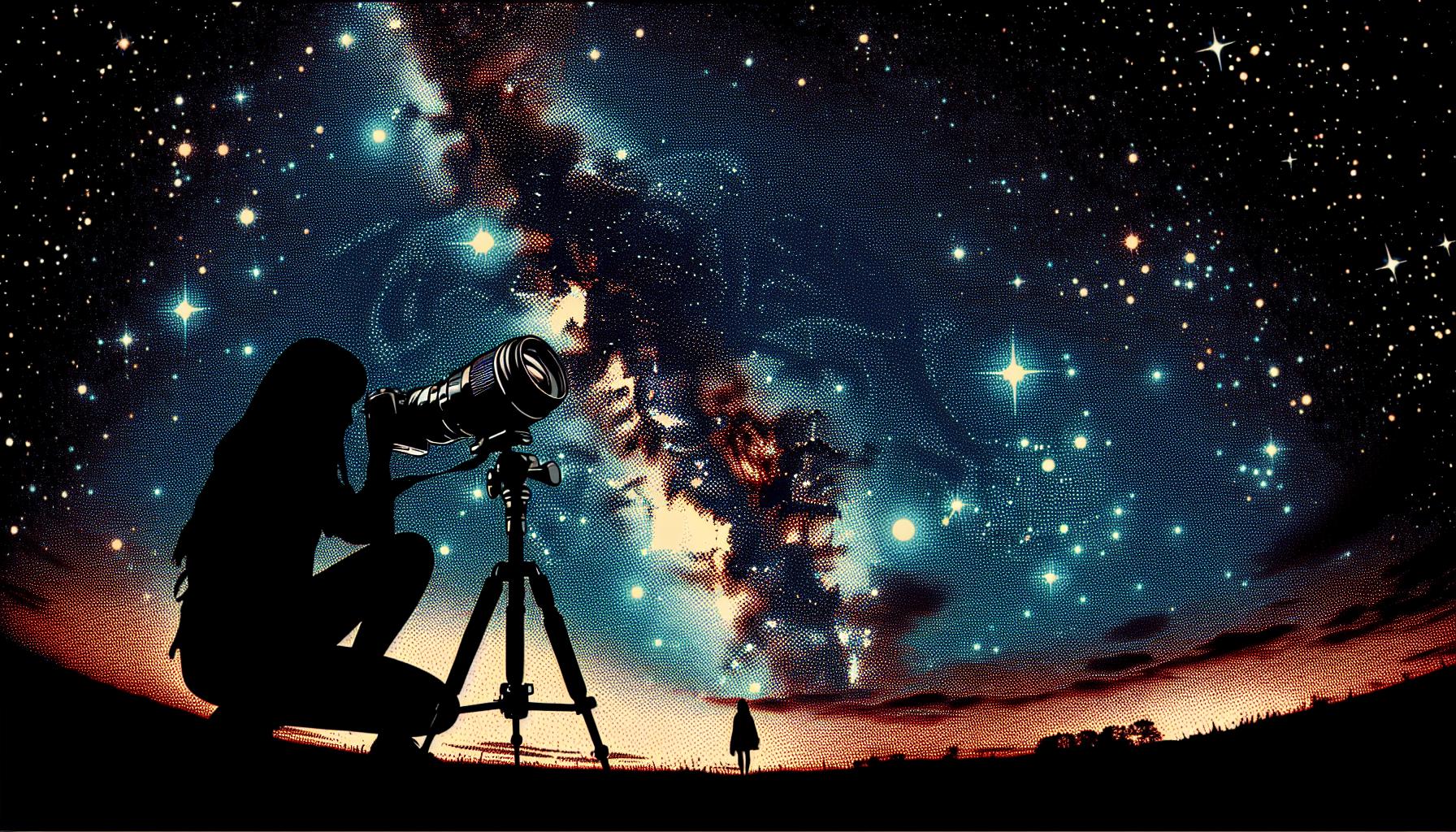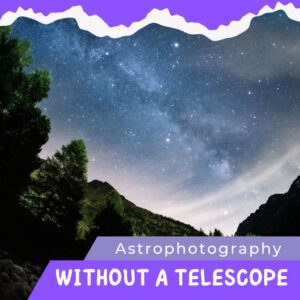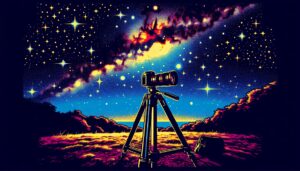This site contains affiliate links to products. I may receive a commission for purchases made through these links.
If you’re as fascinated with the night sky as I am, you’ll know that astrophotography is no easy task. It requires not just skill, but also the right equipment. That’s where the Sony a6000 comes in. Compact yet powerful, it’s a game-changer in the world of astrophotography.
The Sony a6000 offers a blend of features that make it a top contender for your astrophotography needs. With its high ISO range, fast autofocus, and impressive sensor, it’s designed to capture the night sky in all its glory. But what really sets it apart? Let’s dive in and find out.
ISO Range and Low Light Performance
Mastering astrophotography requires navigating through large ISO ranges and demanding low-light settings. It’s where the Sony a6000 really excels.
One of the most laudable features of the Sony a6000 is its high ISO range, which stretches from ISO 100 – 25600. This extensive range provides more flexibility when shooting in less than ideal light conditions. It helps to keep noise levels at a minimum, even when shooting at higher ISO levels. It’s worth mentioning that the camera’s Auto ISO feature is also quite reliable, stepping up where it needs to in challenging lighting conditions.
When you’re planning an astrophoto session, it’s the low-light performance that can make or break your images. That’s where the a6000 stands a class apart. Its sensor pairs with a powerful BIONZ X image processor for effective noise reduction, leading to sharper and clearer images. It allows you to capture stellar shots of the Milky Way or your favorite constellations in all their celestial glory.
| Feature | Sony a6000 |
|---|---|
| ISO Range | 100 – 25600 |
| Sensor | APS-C (23.5 x 15.6 mm) CMOS Sensor |
| Image Processor | BIONZ X |
The combination of a great ISO range and exceptional low-light performance results in the Sony a6000’s enviable portfolio of excellent astrophotography images. Whether it’s the darkest corners of the cosmos that you’re angling for, or capturing the faintest of stars, this compact powerhouse has got you covered. This is precisely why it’s a top contender for any serious astro-shooter’s gear lineup. No matter where your astrophotography adventures take you, the Sony a6000 is up to the task.
Fast Autofocus for Capturing the Night Sky
Here’s another noteworthy feature of the Sony a6000: its fast autofocus system. When you’re out capturing the night sky, you don’t have time for fumbling around trying to manually focus on distant stars or other celestial bodies. Sony understands this, and they’ve equipped the a6000 with a robust autofocus system to make your astrophotography experiences as seamless as possible.
When you’re aiming your camera at distant stellar objects, what you need is speed and precision. The Sony a6000’s autofocus system doesn’t disappoint. Packed with an impressive 179 autofocus points, this camera ensures you get sharp, clear, and accurately focused images of the night sky swiftly. It takes less than a second – 0.06 seconds to be precise – for the AF system to lock onto an object. That’s why it’s earned the reputation of having the world’s fastest autofocus!
Additionally, let’s discuss a unique feature worth mentioning – the Eye Autofocus. This revolutionary feature allows the camera to accurately focus on eyes, even in low light conditions. Now, you might be asking, “How does this help with astrophotography?” For some specific situations, like capturing distant star clusters that appear just as small dots to our eyes, this feature can be a game-changer. It can sensibly be used to ensure sharp focus over these challenging and distant celestial bodies.
What’s more, the camera’s Continuous AF mode can track celestial bodies across the night sky. So whether you’re capturing the motion of planets or the passage of a comet, the Sony a6000 ensures your masterpiece stays in focus throughout the process. It’s this blend of speed, precision, and versatility that makes the autofocus system of the Sony a6000 a standout, facilitating my astrophotography ventures.
There aren’t many APS-C sensor cameras with this advanced of an autofocus system that I can confidently recommend for astrophotography. So in terms of speed, precision, and utility, the Sony a6000 definitely takes the cake.
Impressive Sensor and Image Quality
Stepping into the impressive sensor and image quality of the Sony a6000, the camera shines with its 24.3-megapixel APS-C sensor. This sensor size offers a perfect balance, providing ample room for good resolution and detail capture without causing undue noise in low light conditions. That’s especially crucial for astrophotography where capturing the minute details of the night sky is of utmost importance.
Its Exmor APS HD CMOS sensor, combined with the Bionz X image processor, ensnares light effectively, resulting in high-quality images. The sensor’s impressive strength lies in its capability to reduce noise, particularly at high ISO levels. It’s the reason those breathtaking astrophotography shots are possible, with their vivid colors, sharp details, and low noise.
Comparing the Sony a6000 with other similar models, we can see that it stands out in terms of image quality. Below, I’ve put together a short table showing how the Sony a6000 stacks against the Canon 70D and Nikon D7200.
| Sony a6000 | Canon 70D | Nikon D7200 | |
|---|---|---|---|
| Sensor Resolution | 24.3 MP | 20.2 MP | 24.2 MP |
| ISO Range | 100-25600 | 100-12800 | 100-25600 |
| Image Processor | Bionz X | DIGIC 5+ | EXPEED 4 |
The Sony a6000, clearly takes the lead, boasting better sensor resolution and an equal ISO range with the Nikon D7200, but far superior to the Canon 70D. Throw in its advanced image processor into the mix, and there’s no denying that the a6000 leads the pack.
Furthermore, the dynamic range of the a6000 also impresses. It does a fantastic job capturing detail in both the dark and bright parts of an image, an essential factor for astrophotography in helping to distinguish between varying degrees of light and shade in the night sky.
Compact and Portable Design
Adding to the technical prowess of the Sony a6000, this camera possesses an awesome feature that truly makes it a go-to choice for astrophotography. That feature is its compact and portable design. This lightweight design adds so much value for those who enjoy capturing stunning astrological imagery while on the move.
Given the often remote and challenging locations for astrophotography, portability is a must-have feature for any equipment used. The Sony a6000 excels in this aspect. Weighing only 344 grams (with battery and memory card), the camera provides an effortlessly portable option for astro-photographers.
Size and weight details are provided in the following table:
| Component | Size/Weight |
|---|---|
| Weight (with battery and memory card) | 344 grams |
| Dimensions | 120 x 67 x 45 mm |
Despite its compact size, the camera doesn’t compromise in any of its features. It’s not only lightweight but also sturdy and — quite importantly for astrophotographers working in a variety of outdoor environments — resistant to a range of weather conditions.
The Sony a6000 also has a comfortable, handheld design that allows for a natural and comfortable grip, even during long hours of shooting. This design is especially beneficial allowing you to effortlessly achieve stability, which is crucial for astrophotography.
Thrilled about the compact and portable design, the Sony a6000 admirers also appreciate the camera’s reasonably sized LCD screen and electronic viewfinder. Both assets lend to an enriched user experience.
So, as you can see, the Sony a6000’s compact and portable design doesn’t fall short — it adds to the camera’s appeal as a powerful tool for astrophotography. It not only ensures an edge in capturing stunning images of celestial bodies but also in transporting this photographic gem to those off-the-beaten-path locations where the night sky truly shines. As I delve deeper into the Sony a6000’s features, I find just how this camera was designed with the needs of serious astrophotographers in mind providing unparalleled portability without sacrificing functionality.
Special Features for Astrophotography
Continuing with our exploration of the Sony a6000, let’s dive into the features that make this camera a solid choice for astrophotography. It’s not just about the compact design or advanced tech specs. The Sony a6000 offers some specialized features that can be a game-changer for astrophotography enthusiasts.
One significant attribute: its In-body Image Stabilization (IBIS). Even a tiny movement can blur an astrophoto, given the slow shutter speeds used. Thankfully, the Sony a6000’s IBIS technology reduces camera shake and delivers clear, detailed shots of stars, galaxies, and other celestial bodies.
The Sony a6000 also flaunts an excellent bulb mode for those long exposure shots. This mode enables the shutter to stay open as long as you hold down the shutter button, giving the camera enough time to absorb the faintest light from distant stars.
A very useful feature for astrophotography is Sony a6000’s focus peaking function. Focus peaking assists in achieving razor-sharp focus on celestial objects. Highlighted edges of your intended subject indicate whether it’s in focus, making it easier to see and adjust.
Furthermore, the silent shooting feature of the Sony a6000 is a boon for astrophotographers. The absence of shutter sound and vibration allows for undisturbed shooting which is essential for capturing high-quality astro-images.
Let’s not forget Sony’s wide range of E-mount lenses. These compatible lenses offer a whole new level of flexibility for your astrophotography endeavors, combining high resolution with compact size.
The special features table sums up the attributes that make Sony A6000 a great astrophotography camera.
| Special Features | Details |
|---|---|
| In-body image stabilization | Enables clear, detailed astro-images |
| Bulb mode | Allows longer exposure for faint light absorption |
| Focus peaking function | Aids in achieving sharp focus on celestial objects |
| Silent shooting feature | Provides undisturbed shooting for better quality astro-images |
| Support for E-mount lenses | Offers high resolution and flexibility |
Conclusion
So there you have it. The Sony a6000’s high ISO range and low-light performance make it a standout for astrophotography. Its fast autofocus system and superior image quality ensure you’ll capture the night sky in all its glory. With features like in-body image stabilization, bulb mode, focus peaking, silent shooting, and E-mount lens support, it’s clear why this camera is a top pick.
Its compact and portable design is just icing on the cake. If you’re looking to capture breathtaking images of the cosmos, the Sony a6000 won’t let you down. It’s more than a camera, it’s your ticket to the stars.
Frequently Asked Questions
What is the Sony a6000’s suitability for astrophotography?
The Sony a6000 is highly suitable for astrophotography due to its high ISO range, low-light performance, fast autofocus system, and impressive sensor and image quality.
What specialized features does the Sony a6000 offer for astrophotography?
The specialized features for astrophotography include in-body image stabilization, bulb mode for long exposures, focus peaking for achieving sharp focus on celestial objects, silent shooting, and support for E-mount lenses.
How does the Sony a6000’s size and design benefit astrophotography?
The compact and portable design of the Sony a6000 makes it easy to carry, ideal for capturing celestial images in remote and challenging locations.
Does the Sony a6000 have a bulb mode for long exposure shots?
Yes, the Sony a6000 includes a bulb mode feature, essential for long exposure shots commonly used in astrophotography.
What is focus peaking and how is it useful in the Sony a6000 for astrophotography?
Focus peaking is a function that highlights the areas of your frame that are in sharp focus. It’s particularly useful in astrophotography for ensuring your celestial objects are precisely focused. The Sony a6000 does include this feature.




